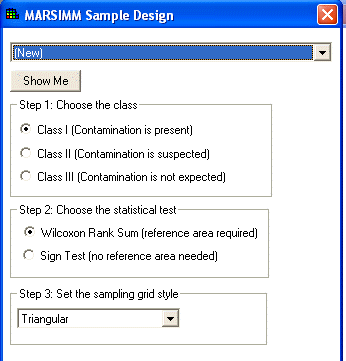
This step is used to set the parameters for a MARSSIM sample design. This step is only available when the Develop a sample design interview is selected.
Select MARSSIM Parameters from the Steps Window. The Parameters Window will display the following.

Step 1: Choose the class
Class I Areas: Areas containing locations where, prior to remediation, the concentrations of residual radioactivity may have exceeded the DCGLW.
Class II Areas: Areas containing no locations where, prior to remediation, the concentrations of residual radioactivity may have exceeded the DCGLW.
Class III Areas: Areas with a low probability of containing any locations with residual radioactivity.
Class I areas have the highest potential for containing small areas of elevated activity exceeding the release criterion. Therefore, both the number of sampling locations and the extent of scanning effort is greatest. The sampling effort is driven by the goal of finding areas with concentrations in exceedance of the DCGLEMC. Sampling is done on a systematic grid and the distance between sampling locations is made small enough so that any elevated area that might be missed by sampling would be found by scanning.
Class II areas may contain residual radioactivity, but the potential for elevated areas is very small. Sampling is done on a systematic grid and the distance between samples is limited by limiting the maximum size of the survey unit. Scanning coverage ranges from 10-100% depending on the potential for elevated areas.
Class III areas should contain little, if any, residual radioactivity. There should be virtually no potential for elevated areas. Sampling is random across the unit and the sampling density can be very low. Scanning is performed on a judgmental basis.
Step 2: Choose the statistical test
The type of test that is performed depends on whether the radionuclide is naturally present in background or not. If the contaminant is present in background, then data for the contaminant is collected from a reference area and the Wilcoxon Rank Sun test is performed. If the contaminant is not expected to be present in reference samples, then the Sign Test is performed.
Step 3: Set the sampling grid style
For Class I and II areas where systematic sampling is performed, the grid designs can be either triangular or square. Generally, triangular grids are preferred to square grids for systematic sample designs due to its ability to minimize the area of a missed hot spot with the same number of samples.